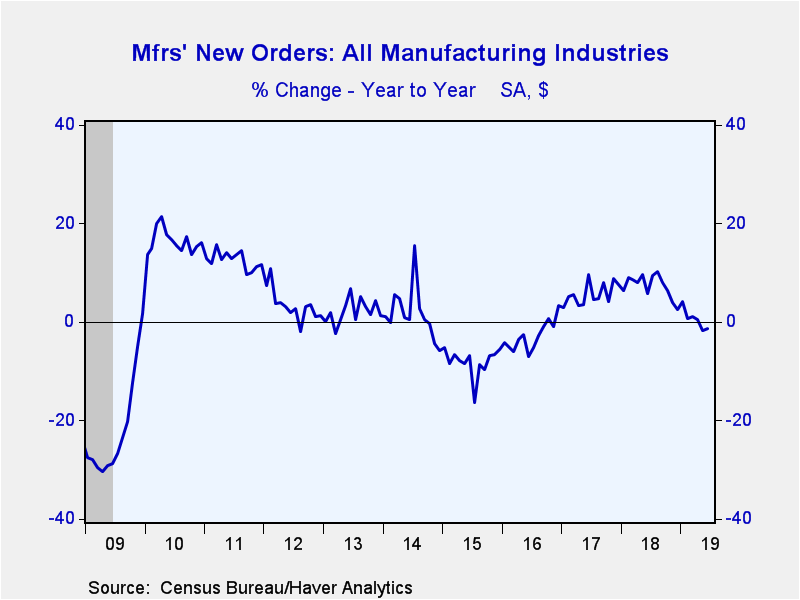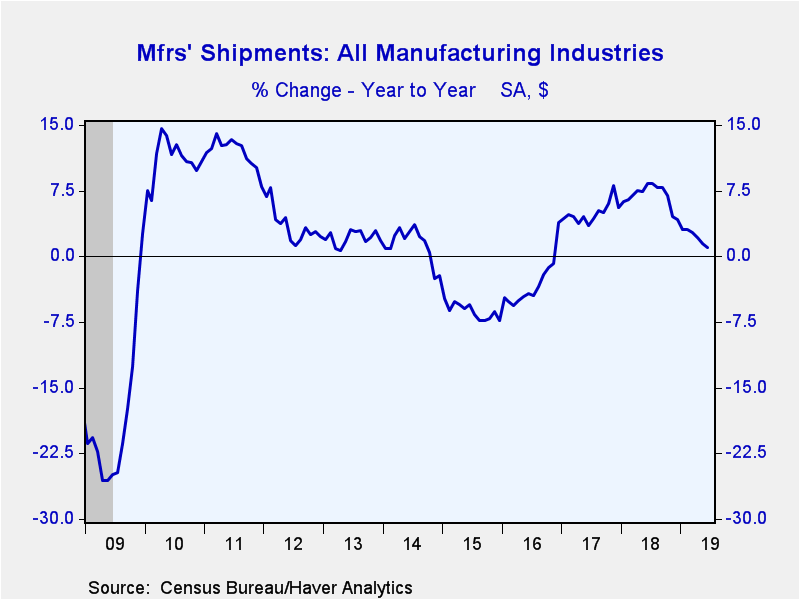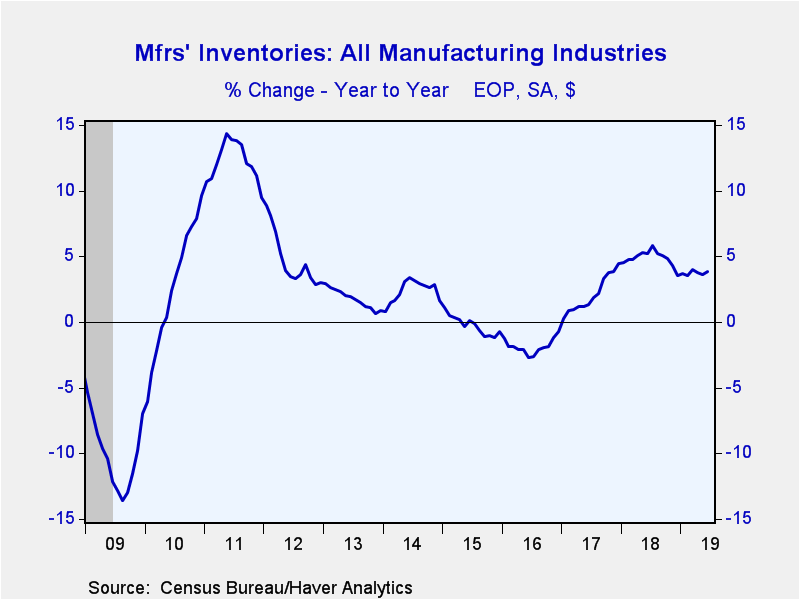 Global| Aug 02 2019
Global| Aug 02 2019Factory Orders and Shipments Post Gains in June
by:Sandy Batten
|in:Economy in Brief
Summary
Manufacturers' orders rose 0.6% (-1.2% year-on-year) in June following declines in each of the previous two months. Orders fell 1.2% m/m in April and 1.3% m/m in May. The Action Economics Forecast survey looked for a 0.6% increase. [...]
Manufacturers' orders rose 0.6% (-1.2% year-on-year) in June following declines in each of the previous two months. Orders fell 1.2% m/m in April and 1.3% m/m in May. The Action Economics Forecast survey looked for a 0.6% increase. For all of the second quarter, factory orders fell 5.3% q/q saar. Factory shipments rose 0.4% m/m (1.0% y/y) in June after having edged up 0.1% in May. For all of Q2, shipments were down 0.6% q/q saar. Shipments of nondefense capital goods excluding aircraft (core capital goods), which is one of the key inputs into nonresidential equipment investment in GDP, rose 0.3% in June (+3.1% y/y) and were up 1.7% q/q saar for the second quarter.
Orders in the volatile durable goods sector rebounded in June, rising 1.9% m/m (-1.9% y/y) after declines of 2.8% m/m and 2.3% m/m in April and May, respectively. Orders for transportation equipment once again played a key role in the monthly performance. These orders were up 3.7% m/m in June following falls of 7.6% m/m and 7.5% m/m in April and May, respectively. Total factory orders excluding transportation edged up 0.1% m/m in June versus an unchanged reading in May. The second largest category of orders, fabricated metals, also posted a solid rise in June, increasing 1.7% m/m, its largest monthly increase since April 2018. Orders for nondurable goods did not participate in the June rebound, falling 0.5% m/m (-0.6% y/y) in June on top of a 0.3% m/m decline in May.
Shipments of durable goods increased 1.3% (2.5% y/y) with transportation again playing a key role, rising 3.0% m/m in June. After six consecutive monthly declines, reflecting ongoing problems at Boeing, nondefense aircraft shipments rose 6.0% m/m in June but were still 20.8% lower than a year ago. Shipments of nondurable goods fell 0.5% m/m in June after a 0.3% m/m drop in May. Shipments of petroleum and coal products posted their second consecutive meaningful decline, falling 4.1% m/m in June on top of a 3.0% m/m decline in May. Falling crude oil prices in May and June contributed to the decline in the value of shipments in those months.
Unfilled orders of durable goods, which are the same as unfilled factory orders, contracted 0.7% (-0.3% y/y) in June for their fourth monthly decline in the past five months. This decline was led by falling transportation equipment backlogs, which fell 1.0% m/m for the fourth decline in the past five months fell. Excluding the transportation sector, unfilled orders edged up 0.1% m/m in June.
Inventories of manufactured products rose 0.2% m/m in June, the same monthly gain as in May. Inventories of durable goods increased 0.3% m/m in June while inventories of nondurable goods were unchanged. Excluding the 0.9% m/m rise in inventories of transportation equipment, the inventory of the rest of factory goods was unchanged in June.
All these factory sector figures are available in Haver's USECON database. The expectation figure is in the AS1REPNA database.
| Factory Sector (% chg) - NAICS Classification | Jun | May | Apr | Jun Y/Y | 2018 | 2017 | 2016 |
|---|---|---|---|---|---|---|---|
| New Orders | 0.6 | -1.3 | -1.2 | -1.2 | 7.3 | 5.7 | -2.9 |
| Shipments | 0.4 | 0.1 | -0.6 | 1.0 | 6.9 | 5.0 | -3.2 |
| Unfilled Orders | -0.7 | -0.8 | -0.2 | -0.3 | 3.9 | 1.9 | -1.1 |
| Inventories | 0.2 | 0.2 | 0.2 | 3.9 | 3.5 | 4.5 | -0.7 |
Sandy Batten
AuthorMore in Author Profile »Sandy Batten has more than 30 years of experience analyzing industrial economies and financial markets and a wide range of experience across the financial services sector, government, and academia. Before joining Haver Analytics, Sandy was a Vice President and Senior Economist at Citibank; Senior Credit Market Analyst at CDC Investment Management, Managing Director at Bear Stearns, and Executive Director at JPMorgan. In 2008, Sandy was named the most accurate US forecaster by the National Association for Business Economics. He is a member of the New York Forecasters Club, NABE, and the American Economic Association. Prior to his time in the financial services sector, Sandy was a Research Officer at the Federal Reserve Bank of St. Louis, Senior Staff Economist on the President’s Council of Economic Advisors, Deputy Assistant Secretary for Economic Policy at the US Treasury, and Economist at the International Monetary Fund. Sandy has taught economics at St. Louis University, Denison University, and Muskingun College. He has published numerous peer-reviewed articles in a wide range of academic publications. He has a B.A. in economics from the University of Richmond and a M.A. and Ph.D. in economics from The Ohio State University.










